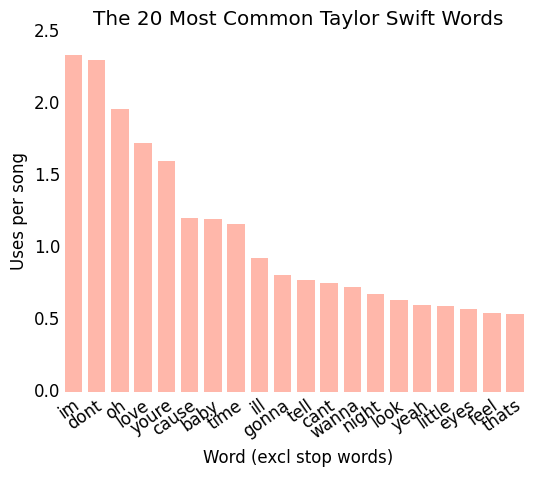By Irene Chen, originally designed for a WECode 2016 workshop
Update (04/25/19): For fans looking for updated lyrics data through Reputation, check out this Kaggle dataset.
Taylor Swift is renowned for her narrative songs. Here we will analyze what makes a Taylor Swift song sound like her songwriting.
There are two parts designed for varying levels of familiarity with Python:
analyze.py: for newer students to find most common unigrams (words) and bigrams (2-word phrases) that Taylor Swift uses
songbird.py: for students more familiar with Python to generate a random song using a Markov Model. One sample output could be:
I'll drive on me is the news.
I'd tell the crowds.
Headlights pass by morning light on you to walk away
like they mean, I know you,
I paced back on me
From the water
That's when you
Remember when you were right to get out
Taylor Swift lyrics are scraped from AZ Lyrics using scrape.py.
Full song data is contained in 'az_lyrics.json' and includes the following fields:
title: song titlealbum: album nameyear: album yearlyrics: lyrics of song (no unicode)
To load song data in Python, use
import json
with open('az_lyrics.json', 'rb') as f:
songs = json.load(f)
The other form of lyric data is in all_tswift_lyrics.txt and will be more relevant for the Markov Model. The file contains all of the song lyrics in one location without any separators or song titles.
To load song lyrics into Python, use
with open('all_tswift_lyrics.txt', 'rb') as f:
lyrics = f.read()
Execises can be found in analyze.py with exercises marked as TODO. As with all code, there are design considerations you must make: How much do you care about punctuation? Upper case letters? How do you feel about stop words?
Once you have completed the listed exercises, feel free to explore! Here are some ideas for further analysis:
- How has the length of songs changed over time (from 2006 to 2014)?
- Which words and phrases frequently appear together in the same song?
- Can we bring in more data (like bpm or chart positions) to do more analysis?
Markov Models are a statistical framework that leverages randomness and memoryless-ness. That is, the next word depends on the word before it and nothing else. Transitions are learned from an original corpus text (here defined as Taylor Swift's lyrics).
As before, exercises can be found in songbird.py with exercises marked TODO. I would urge students to get a working product first and then tinker with things like punctuation and capitalization.
When completed, the code would run as follows
from songbird import Songbird
tswift_bird = Songbird('all_tswift_lyrics.txt')
print tswift_bird.generate(50)
If you have any questions, please reach out to me at irenetrampoline [at] gmail [dot] com
